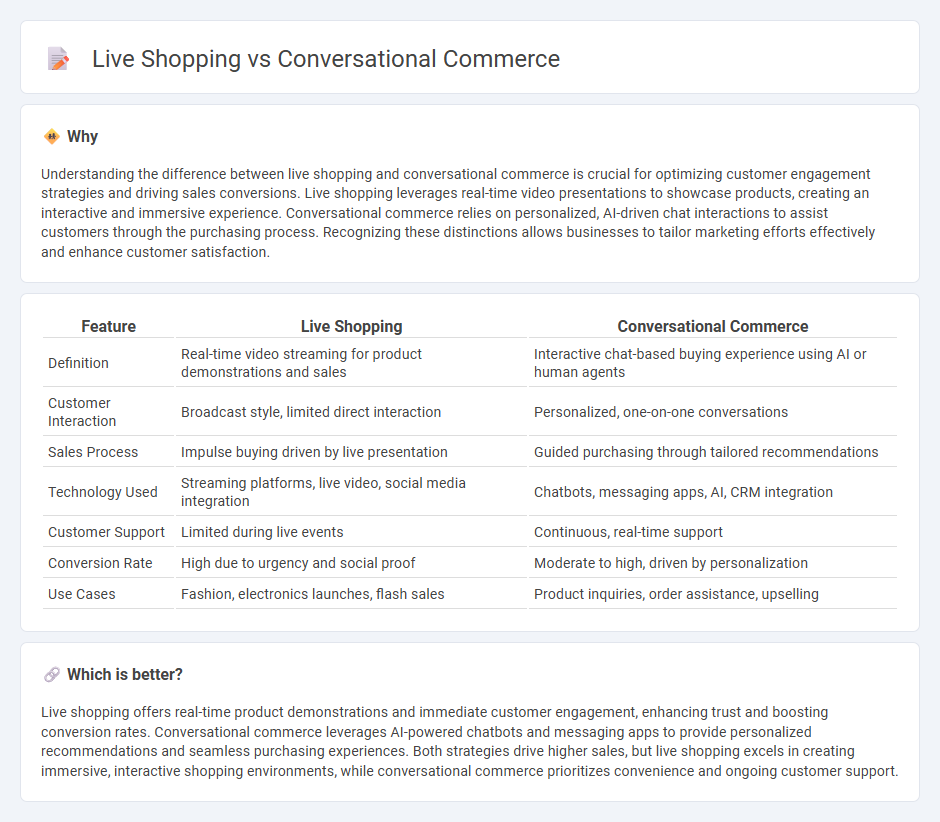
Live shopping integrates real-time video streaming with instant purchasing, creating an interactive retail experience that boosts customer engagement and sales conversion rates. Conversational commerce utilizes chatbots, messaging apps, and AI-driven conversations to personalize shopping by facilitating seamless product discovery and support within communication channels. Explore more to understand how these innovative commerce strategies are transforming the retail landscape.
Why it is important
Understanding the difference between live shopping and conversational commerce is crucial for optimizing customer engagement strategies and driving sales conversions. Live shopping leverages real-time video presentations to showcase products, creating an interactive and immersive experience. Conversational commerce relies on personalized, AI-driven chat interactions to assist customers through the purchasing process. Recognizing these distinctions allows businesses to tailor marketing efforts effectively and enhance customer satisfaction.
Comparison Table
| Feature | Live Shopping | Conversational Commerce |
|---|---|---|
| Definition | Real-time video streaming for product demonstrations and sales | Interactive chat-based buying experience using AI or human agents |
| Customer Interaction | Broadcast style, limited direct interaction | Personalized, one-on-one conversations |
| Sales Process | Impulse buying driven by live presentation | Guided purchasing through tailored recommendations |
| Technology Used | Streaming platforms, live video, social media integration | Chatbots, messaging apps, AI, CRM integration |
| Customer Support | Limited during live events | Continuous, real-time support |
| Conversion Rate | High due to urgency and social proof | Moderate to high, driven by personalization |
| Use Cases | Fashion, electronics launches, flash sales | Product inquiries, order assistance, upselling |
Which is better?
Live shopping offers real-time product demonstrations and immediate customer engagement, enhancing trust and boosting conversion rates. Conversational commerce leverages AI-powered chatbots and messaging apps to provide personalized recommendations and seamless purchasing experiences. Both strategies drive higher sales, but live shopping excels in creating immersive, interactive shopping environments, while conversational commerce prioritizes convenience and ongoing customer support.
Connection
Live shopping and conversational commerce intersect by integrating real-time interactions with instant purchasing options, enhancing customer engagement and boosting conversion rates. Live shopping leverages video streams where consumers ask questions and receive immediate responses through conversational commerce tools like chatbots or live agents. This fusion creates a seamless, interactive retail experience that combines entertainment with personalized shopping assistance.
Key Terms
Conversational Commerce:
Conversational commerce leverages AI-powered chatbots and messaging platforms to provide personalized shopping experiences, enabling consumers to interact directly with brands for product recommendations, support, and seamless transactions. This approach enhances customer engagement by facilitating real-time communication and tailored offers based on user preferences and behavior. Explore how conversational commerce is transforming digital retail and driving higher conversion rates.
Chatbots
Conversational commerce leverages AI-powered chatbots to provide personalized shopping experiences through messaging apps and websites, enabling real-time customer support and seamless transactions. Live shopping integrates real-time video streaming with interactive chatbots to engage audiences directly, creating an immersive and dynamic retail environment. Explore how chatbot technology revolutionizes both conversational commerce and live shopping to boost sales and enhance customer engagement.
Messaging Apps
Conversational commerce leverages messaging apps like WhatsApp and Facebook Messenger to facilitate personalized customer interactions and seamless transactions through chat-based interfaces. Live shopping integrates real-time video streaming with instant messaging features, allowing viewers to engage with hosts and make purchases directly within the app. Explore how messaging apps transform customer engagement by blending conversational commerce with live shopping experiences.
Source and External Links
What is conversational commerce? Examples, types, + benefits - Conversational commerce refers to how e-commerce brands use messaging and conversational technology like chatbots and messaging apps to enhance the shopping experience by providing real-time assistance and personalized recommendations throughout the customer journey.
What Is Conversational Commerce? Definition and Guide - Shopify - It involves chatbots, messaging apps, voice assistants, and SMS to facilitate online shopping and customer interactions, making the purchase process more intuitive and personalized, such as ordering through Facebook Messenger or using voice commands with Amazon Alexa.
What Is Conversational Commerce? | Salesforce US - Conversational commerce enhances sales by enabling direct, personalized communication between businesses and customers via chatbots, live agents, and voice assistants, making shopping feel like a natural, friendly conversation integrated into everyday life.
 dowidth.com
dowidth.com